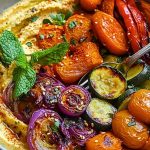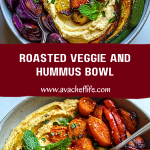Colorful, hearty, and bursting with flavor, the Roasted Veggie and Hummus Bowl is a nourishing celebration of plant-based goodness. This dish brings together an irresistible medley of caramelized roasted vegetables — including golden carrots, vibrant bell peppers, and sweet red onions — served over a luscious bed of creamy hummus. Finished with a sprinkle of sesame seeds and fresh mint, this bowl doesn’t just nourish your body — it excites your senses with contrasting textures, savory depth, and bright garnishes.

Ideal for lunch, dinner, or even a wholesome meal prep option, this bowl is endlessly adaptable. Whether you’re vegan, vegetarian, or simply looking to incorporate more vegetables into your meals, this bowl offers a satisfying and flavorful way to do it. With simple ingredients and straightforward prep, you’ll want to make this your go-to comfort bowl year-round.
Why You’ll Love This Roasted Veggie and Hummus Bowl
- Deeply satisfying: The combination of warm, caramelized vegetables with creamy, tangy hummus is a flavor match made in heaven.
- Highly customizable: Switch up the veggies based on seasonality or what you have on hand.
- Nutrient-dense and plant-powered: Packed with fiber, vitamins, and plant-based protein.
- Meal-prep friendly: Make ahead and store in portions for grab-and-go meals throughout the week.
- Visually stunning: A feast for the eyes and the palate — ideal for sharing or serving to guests.
Preparation Phase & Tools to Use for the Roasted Veggie and Hummus Bowl
Before diving into cooking, a bit of thoughtful prep makes all the difference. Having the right tools ensures your vegetables roast evenly and your hummus is smooth and creamy.
Essential Tools and Their Importance:
- Sheet Pan: The star of this dish. A large rimmed sheet pan allows the veggies to spread out in a single layer, ensuring crisp, caramelized edges rather than steamed, soggy results.
- Sharp Chef’s Knife: Precision slicing is key — you want uniform vegetable pieces so they cook at the same rate.
- Cutting Board: Use a large, stable cutting surface to comfortably handle various veggies.
- Blender or Food Processor: If making hummus from scratch, this will give you that ultra-smooth, fluffy consistency.
- Mixing Bowls: Handy for tossing vegetables in olive oil and seasoning.
- Spatula or Tongs: Useful for flipping veggies halfway through roasting to get that beautiful golden char on all sides.
Preparation Tips
- Cut Evenly: Aim for similar-sized vegetable chunks so they roast uniformly. For example, halve or quarter carrots if they’re thick.
- Dry Your Veggies: After washing, pat vegetables dry to avoid steam and help with browning.
- Don’t Overcrowd the Pan: Roast in batches if needed — crowded pans trap moisture and prevent caramelization.
- Use Parchment Paper: Makes cleanup easier and helps prevent sticking.
- Season Generously: Olive oil, sea salt, freshly ground pepper, and optionally, a sprinkle of cumin or smoked paprika for depth.
- Roast at High Heat: Around 425°F (220°C) for deep browning and crispy edges.
Ingredients for This Roasted Veggie and Hummus Bowl
Creating a nourishing bowl begins with selecting fresh, high-quality ingredients. This recipe celebrates vibrant vegetables and creamy hummus, tied together with aromatic herbs and a few finishing touches.
For the Roasted Vegetables:
- 1 medium red onion, peeled and quartered
- 1 cup cherry tomatoes or grape tomatoes
- 1 large red bell pepper, sliced into strips
- 1 large orange or yellow bell pepper, sliced into strips
- 1 medium zucchini, halved lengthwise or quartered
- 2 medium carrots, sliced into 1/4-inch coins
- 1/2 small eggplant or acorn squash, sliced into half-moons
- 2 tablespoons olive oil
- 1 teaspoon sea salt
- 1/2 teaspoon black pepper
- 1/2 teaspoon cumin (optional, for warmth)
For the Hummus (if making from scratch):
- 1 1/2 cups cooked chickpeas (or 1 can, drained and rinsed)
- 1/4 cup tahini
- 2 tablespoons lemon juice
- 1 garlic clove, minced
- 2–4 tablespoons cold water (for desired consistency)
- 1/2 teaspoon salt
- 2 tablespoons olive oil, for drizzling
Toppings & Garnish:
- Sesame seeds, for sprinkling
- Fresh mint leaves
- Chopped parsley
- Extra virgin olive oil, for drizzling

Step 1: Prep the Vegetables
Start by preheating your oven to 425°F (220°C). While the oven heats, wash and dry all your vegetables thoroughly. Peel the red onion and cut into quarters. Slice the bell peppers into thick strips, halve or quarter the zucchini and carrots depending on size, and cut the eggplant or squash into thin half-moons. Leave the cherry tomatoes whole.
Step 2: Season and Arrange for Roasting
Place all the chopped vegetables into a large mixing bowl. Add 2 tablespoons of olive oil, salt, pepper, and optional cumin. Toss well to coat evenly. Transfer the vegetables to a large baking sheet lined with parchment paper. Spread them out in a single layer — don’t crowd the pan or the veggies will steam instead of roast.
Step 3: Roast the Veggies
Slide the sheet pan into the oven and roast for 25–30 minutes, flipping the vegetables halfway through to ensure even browning. The veggies are done when they’re tender and slightly charred at the edges — especially the onions and peppers, which should have a deep caramel color.
Step 4: Prepare the Hummus (if making fresh)
While the veggies roast, add chickpeas, tahini, lemon juice, garlic, and salt into a food processor or high-speed blender. Blend until smooth, scraping down sides as needed. Slowly add cold water, one tablespoon at a time, until the hummus is creamy and light. Taste and adjust seasoning. Drizzle with olive oil before serving.
Step 5: Assemble the Bowl
Spoon a generous portion of hummus into each bowl, spreading it into a wide, shallow base. Arrange the roasted vegetables around and slightly over the hummus. Garnish with fresh mint leaves, a sprinkle of sesame seeds, chopped parsley, and a final drizzle of olive oil.
Step 6: Serve and Enjoy
Serve immediately while the vegetables are still warm, letting the hummus bring a creamy contrast to the roasted textures. For extra crunch, consider adding a few toasted pita chips or a scoop of cooked grains like quinoa or couscous.
Notes
- Homemade vs Store-Bought Hummus: While fresh hummus adds an unmatched creaminess and flavor, store-bought versions are perfectly acceptable for convenience. Opt for one with minimal ingredients and no added sugar or preservatives.
- Vegetable Variations: Feel free to swap in seasonal produce — think roasted cauliflower in winter or asparagus in spring. Just adjust roasting time accordingly.
- Batch Cooking: Double the roasted veggies and store extras for other meals. They’re excellent in wraps, salads, or as a side dish.
- Gluten-Free Option: This dish is naturally gluten-free. If adding grains or pita, choose gluten-free versions if needed.
- Protein Boost: For extra protein, top your bowl with roasted chickpeas or a handful of hemp seeds.
Watch Out for These Mistakes While Cooking
- Overcrowding the Pan: This is the most common mistake. When vegetables overlap, they steam instead of roast, resulting in soggy textures. Spread them out well or use two sheet pans if needed.
- Undercooked Carrots or Squash: Dense veggies like carrots and squash take longer to roast. Slice them thinner or start roasting them a few minutes earlier than softer vegetables.
- Skipping the Flip: Not turning vegetables halfway through can cause uneven browning. Use tongs or a spatula to gently toss for a balanced roast.
- Using Wet Vegetables: Always pat veggies dry after washing. Moisture hinders caramelization and encourages steaming.
- Underseasoning: With simple ingredients, seasoning is key. Don’t be afraid to taste and adjust salt, lemon, or spices — especially in hummus.
- Too Much Oil: A light coating of oil is enough. Excess oil can make veggies greasy and may burn in the oven.
- Blending Hot Chickpeas: If making hummus with freshly cooked chickpeas, let them cool slightly before blending to avoid bitterness and overheating your blender.
- Serving Everything Cold: This dish shines when the roasted veggies are warm. Even if you’re using pre-prepped hummus, let it come to room temp for the best contrast.
What to Serve With Roasted Veggie and Hummus Bowl?
While the Roasted Veggie and Hummus Bowl is a complete and satisfying meal on its own, it pairs beautifully with a variety of side dishes and add-ons to elevate your dining experience.
8 Recommendations:
- Warm Pita Bread or Pita Chips
Perfect for scooping up hummus and roasted veggies. Toast lightly for added crunch and warmth. - Lemon-Herb Quinoa
A zesty grain side balances the creamy hummus and adds texture and protein for a more filling bowl. - Greek Yogurt or Tzatziki
A dollop of this cool, tangy yogurt-based sauce adds a refreshing contrast to the warm, spiced vegetables. - Stuffed Grape Leaves (Dolmas)
These bring a touch of Mediterranean flavor and make for a sophisticated addition. - Pickled Veggies or Olives
The tanginess of pickled red onions, cucumbers, or kalamata olives enhances every bite with sharp contrast. - Chickpea Fritters or Falafel
For a heartier version of the bowl, top it with baked or fried falafel for added protein and crunch. - Crispy Roasted Chickpeas
Sprinkle these on top for texture, protein, and an extra crunch that complements the soft hummus base. - Arugula or Baby Greens Salad
Lightly dressed greens bring freshness and a peppery bite that contrasts the earthy roasted vegetables.
Storage Instructions
The Roasted Veggie and Hummus Bowl stores well, making it a fantastic option for meal prep and leftovers. To maintain freshness and texture, follow these tips:
- Separate Components: Store roasted vegetables and hummus separately in airtight containers. This prevents the veggies from softening the hummus and helps both last longer.
- Refrigeration: Keep both components refrigerated. Roasted vegetables stay fresh for up to 4 days, while homemade hummus can last 5–7 days.
- Reheating Tips: Reheat veggies in a toaster oven or on a skillet to bring back their roasted texture — avoid the microwave if possible to prevent sogginess. Serve hummus at room temperature or slightly warmed for best flavor.
- Freezing: Roasted vegetables can be frozen for up to 2 months, though some may lose their texture upon thawing. Hummus can also be frozen, but stir well after thawing to restore smoothness.
Estimated Nutrition (Per Serving — approximately 1 bowl)
Note: Values are approximate and may vary based on portions and substitutions.
- Calories: ~400–450 kcal
- Protein: 10–12 g
- Fat: 20–25 g (mostly from olive oil and tahini)
- Carbohydrates: 45–50 g
- Fiber: 10–12 g
- Sugars: 7–10 g (mostly from vegetables)
- Sodium: ~400–600 mg
- Vitamin A: 120% DV
- Vitamin C: 90% DV
- Iron: 15–20% DV
- Calcium: 8–10% DV
This bowl provides a well-rounded blend of healthy fats, plant-based protein, and complex carbs — perfect for a nourishing, balanced meal.
Frequently Asked Questions
1. Can I use store-bought hummus instead of homemade?
Absolutely. Store-bought hummus is a great time-saver. Look for versions made with minimal, clean ingredients. You can also jazz it up with a drizzle of olive oil, paprika, or chopped herbs.
2. Can I make this bowl ahead of time?
Yes! Roast the vegetables and prepare the hummus up to 3–4 days in advance. Store them separately in airtight containers and assemble the bowl when ready to eat.
3. Is this recipe vegan and gluten-free?
Yes, it’s naturally vegan and gluten-free. Just make sure any extras you add — like pita or grains — are certified gluten-free if needed.
4. What vegetables can I substitute?
You can use virtually any roastable vegetable: cauliflower, sweet potatoes, mushrooms, broccoli, or even Brussels sprouts. Adjust the roasting time depending on density.
5. How do I get my hummus extra smooth?
Use a high-speed blender or food processor. Peel your chickpeas (or use canned ones without skins), and add ice-cold water gradually while blending for a creamier result.
6. What spices go well with this dish?
Smoked paprika, cumin, coriander, za’atar, turmeric, and chili flakes all pair beautifully with the vegetables and hummus.
7. Can I add grains to the bowl?
Yes! Quinoa, couscous, brown rice, or bulgur make excellent additions. They bulk up the bowl and add more nutrients and texture.
8. How do I avoid soggy vegetables when reheating?
Avoid the microwave. Instead, reheat in a hot skillet or in the oven at 375°F (190°C) for 5–8 minutes to restore crisp edges.
Conclusion
The Roasted Veggie and Hummus Bowl isn’t just a recipe — it’s a vibrant, wholesome experience in every bite. With its blend of warm roasted vegetables, cool and creamy hummus, and a rainbow of textures and flavors, this bowl can fit into your life whether you’re eating clean, meal prepping, or entertaining. It’s flexible, nourishing, and full of personality — much like the person who makes it.

Roasted Veggie and Hummus Bowl
- Prep Time: 15 minutes
- Cook Time: 30 minutes
- Total Time: 45 minutes
- Yield: 2-3 servings
Description
A colorful, hearty plant-based bowl loaded with caramelized roasted vegetables and creamy hummus. Garnished with fresh herbs and sesame seeds, this dish offers a balanced mix of warm textures and cool, creamy richness. Ideal for lunches, meal prep, or a vibrant dinner, it’s both healthy and indulgent.
Ingredients
For the Roasted Vegetables:
- 1 medium red onion, quartered
- 1 cup cherry tomatoes
- 1 large red bell pepper, sliced
- 1 large yellow or orange bell pepper, sliced
- 1 medium zucchini, halved or quartered
- 2 medium carrots, sliced
- 1/2 small eggplant or acorn squash, sliced
- 2 tbsp olive oil
- 1 tsp sea salt
- 1/2 tsp black pepper
- 1/2 tsp cumin (optional)
For the Hummus (optional):
- 1 1/2 cups cooked chickpeas (or 1 can, rinsed)
- 1/4 cup tahini
- 2 tbsp lemon juice
- 1 garlic clove, minced
- 2–4 tbsp cold water
- 1/2 tsp salt
- 2 tbsp olive oil
Garnish:
- Sesame seeds
- Fresh mint leaves
- Chopped parsley
- Olive oil drizzle
Instructions
- Preheat oven to 425°F (220°C). Line a sheet pan with parchment paper.
- Wash, dry, and chop all vegetables evenly. Pat them dry.
- Toss veggies with olive oil, salt, pepper, and cumin (if using). Spread in a single layer on the pan.
- Roast for 25–30 minutes, flipping halfway, until edges are golden and caramelized.
- Meanwhile, blend chickpeas, tahini, lemon juice, garlic, and salt until smooth. Add cold water gradually to reach desired consistency. Drizzle in olive oil before serving.
- To serve, spread hummus into bowls. Arrange roasted vegetables over hummus.
- Garnish with sesame seeds, mint, parsley, and a drizzle of olive oil.
- Serve warm or at room temperature.

